Brief History of our School-based Biotechnology Curriculum
In 2004, Po Leung Kuk Laws Foundation College (PLKLFC) was established. In the first academic year 2004/2005 of PLKLFC, a school-based biotechnology curriculum was launched for our S.1 students. To support the practical lessons in biotechnology, our Biotechnology Laboratory equipped with cell culture facilities was established in January, 2005. The biotechnology curriculum for Secondary 2 and 3 students was built up in the academic year of 2005/2006 and 2006/2007, respectively. To share our experience in the development of school-based biotechnology curriculum, our team of biotechnology teachers and school Principal were invited to present the topics titled “The Development of a School-Based Science Curriculum (Biotechnology): Let us work together to make a difference” in “iLongman - Integrated Science Seminar” on March 24, 2007 and “Do we need to do something to our primary and junior secondary science curriculum?” in “Learning for the Future” Series on January 10, 2009, respectively. In order that our Biotechnology Laboratory can support more diverse types of advanced experiments in biotechnology like real-time PCR, DNA fingerprinting, large-scale plant tissue culture and microbial culture, the 2nd phase laboratory development was initiated in 2012. About HK$950,000 was utilized to purchase advanced-level equipment which can support research-based learning in biotechnology lessons and other programs such as Neuroscience Club for scientifically gifted students. In 2013, our biotechnology teachers presented a paper titled “Effectiveness of the school-based Biotechnology curriculum – a science gifted programme for all” in the International Conference of East-Asian Association for Science Education 2013 to mark the important milestone of the development of our school-based biotechnology curriculum. In 2006, 2008, 2010, 2013 and 2015, our students presented their research findings in international conferences in USA. On November 4, 2014, our school received a generous donation from DiagCor Bioscience Incorporation Limited for supporting the future development of our biotechnology curriculum.
On November 4, 2014, Prof. Joseph Wing-On TAM, CEO & Chairman of the Board, DiagCor Bioscience Inc. Ltd. and Mr. Matt AU, COO and CFO of DiagCor Bioscience Inc. Ltd. visited our biotechnology laboratory. They appreciated the research-based learning approach in our gifted education programme in science and gave us advice on further development of biotechnology education.

Our students were presenting a research project about DNA analysis of horseshoe crabs.
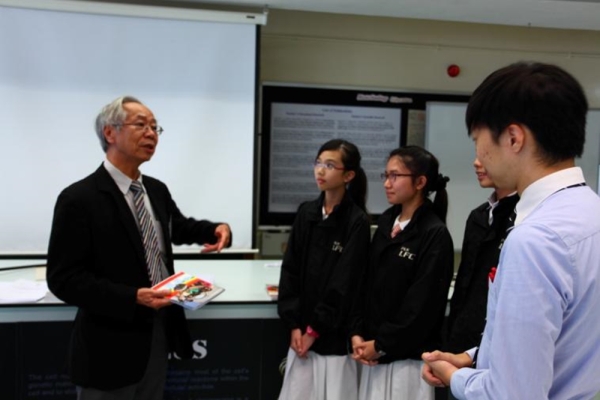
Prof. TAM was introducing research methods in DNA applications.

Prof. TAM was sharing his vision in science education.
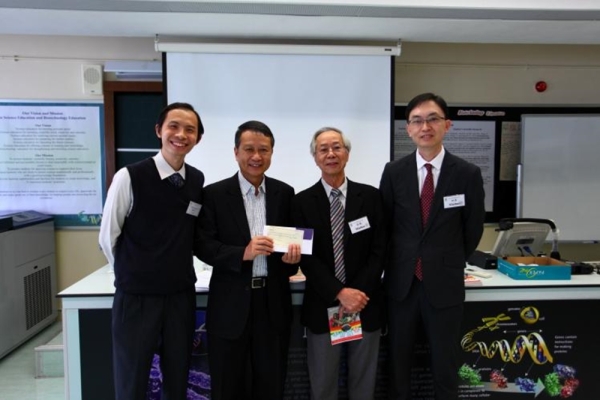
Mr. Wing-Kwong CHAN, Principal of PLKLFC, on behalf of PLKLFC, was pleased to receive the generous support from DiagCor Bioscience Inc. Ltd. for the future development of our school-based biotechnology curriculum.
To recognize the generosity of DiagCor Bioscience Incorporation Limited, our biotechnology laboratory is named as DiagCor Biotechnology Laboratory. The Grand Opening of DiagCor Biotechnology Laboratory was officiated by Professor Yuk-Lam LO, Honorary Chairman of Hong Kong Biotechnology Organization and acknowledged by PLK Board of Directors 2014-2015 chaired by Ms. On-Kei LEONG on March 16, 2015.

Students from our affiliated primary school, Po Leung Kuk Luk Hing Too Primary School showed great interest in plant tissue culture.

The Dedication Ceremony of DiagCor Biotechnology Laboratory was held on March 16, 2015. The ceremony was officiated by Professor Yuk-Lam LO (fifth left), Honorary Chairman of Hong Kong Biotechnology Organization and acknowledged and chaired by Ms. On-Kei LEONG (fourth left), Chairman of PLK. We thank for the generous donation from Professor Wing-On TAM (third right), C.E.O. & Chairman of the Board, DiagCor Bioscience Inc. Ltd.

The biotechnology laboratory is named as DiagCor Biotechnology Laboratory to recognize the generosity of DiagCor Bioscience Incorporation Limited.
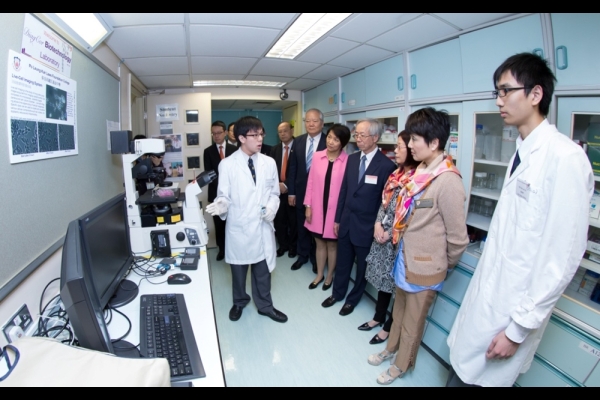
HAU Pak-Chuen (first left) and SHI Pok-Lai (first right), Senior Members of Neuroscience Club were demonstrating how to use the live-cell imaging system to study the death of neuronal cells.

CHOW Pak-Chun (first left), Vice Chairman of Neuroscience Club was explaining the procedures to do bacterial culture for the study of microbial populations in our green roof.
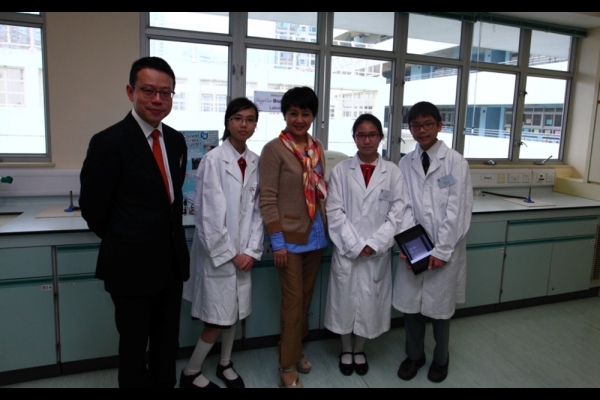
A team of junior form students was demonstrating their ecological study on horseshoe crabs with the use of DNA technologies.
香港01:冠肺炎|母預早稀釋漂白水備用 引子復課後做實驗考究推翻用法 (2020年6月26日)
星島日報:【教育要聞】家居消毒引發好奇心 初中生做實驗解謎團 (2020年6月26日)
大公報:疫情變中學STEM探究題材 (2020年6月26日)
東方日報:新技術治痛風 港生揚威國際 (2020年1月4日)
香港經濟日報:保良局羅氏基金中學設生物科 8成畢業生去年考入大學 (2018年3月28日)
明報:學生實驗隨神舟上太空 一條龍校小一開始學科研 (2016年10月19日)
明報:伙拍港大 學生參與抗癌中藥研究 (2016年10月19日)
明報教得樂學校巡禮:羅氏基金中學置先進實驗儀器 培育下一個諾獎科學家 (2016年4月12日)
STEM教育系列:羅氏基金中學推科研 設實驗室研細胞基因 (2015年12月18日)
科學的未來世界 (2015年5月4日)
「讚好校園」:訪問校長(2015年4月17日)
「讚好校園」:訪問學生(2015年4月17日)
羅氏基金中學 首設腦細胞培植儀 (2015年3月17日)
中學實驗室升呢首設腦細胞培植器 (2015年3月17日)
港生研中藥抗腦癌 (2015年3月17日)
中學首設生物科技實驗室 (2015年3月17日)
中學全港首設腦細胞培植儀促學生參與科研 (2015年3月16日)
啟發探究,培育科學家。 (2014年12月17日)
Currently, our students can carry out advanced research projects in science in our biotechnology laboratory which is equipped with the following facilities:
Equipment |
Biotechnology curriculum |
|---|---|
Microbiological incubator |
Bacterial and fungal culture in S.1 |
Class II biological safety cabinets |
Plant tissue culture and animal cell culture in S.2 |
CO2 incubator for cell culture |
Animal cell culture in S.2 |
Plant growth chamber |
Plant tissue culture in S.2 |
Live-cell imaging system |
Animal cell culture in S.2 ; Fluorescent microscopy for studying cells in culture in S.2 |
Inverted microscopes |
Animal cell culture in S.2 |
High-speed centrifuge |
Extraction and purification of DNA, RNA and Proteins in S.3; Separation of organelles in S.3 |
Real-time PCR machine |
PCR and DNA fingerprinting in S.3; Analysis of gene expression in S.3 |
Spectrophotometer |
Quantitation of DNA and RNA concentration in S.3 |
-86oC deep freezer |
Storage of cells, DNA, RNA and proteins in S.2 and S.3 |
96-well plate reader |
Quantitation of protein concentration in S.3; Bio-assays for studying cellular signaling mechanisms |
Gel documentation system |
Analysis of DNA, RNA and Protein gels in S.3 |
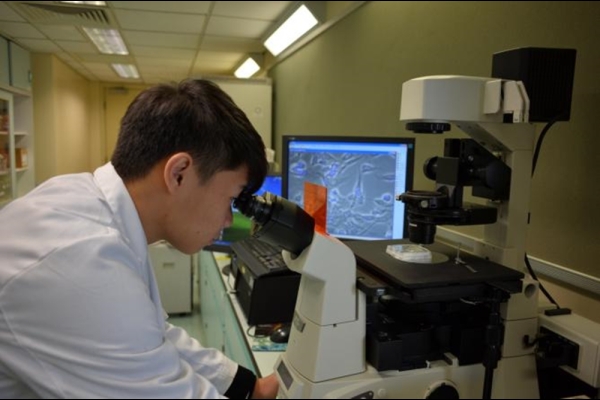
MA Ho-Him, Chairman of Neuroscience Club was observing cultured cells (SH-SY5Y cells) using Live-Cell Imaging System.

CHOW Pak-Chun, Vice Chairman of Neuroscience Club was doing a cell culture experiment in a Class II Safety Cabinet.

Our Biology and Biotechnology Teachers receive Chief Executive’s Award for Teaching Excellence 2016/2017

MA Ho-Him (right) and CHOW Pak-Chun (left) were sharing their research findings in a secondary school in Foshan, China.
Traditional Chinese Medicine
Dendrobium huoshanensecan reduce hydrogen peroxide-induced toxicity in SH-SY5Y cells (Publication in an international conference in USA in 2013)
Gentiana scabra, a type of Chinese Medicine, cannot protect SH-SY5Y cells from oxidative stress (Youth Science & Technology Innovation Competition 2012/2013)
Can the extract of lemon’s seed help against oxidative stress in neurodegeneration? (Youth Science & Technology Innovation Competition 2014/2015)
霍山石斛對抗腦退化症的研究(2015年,第30屆全國青少年科技創新大賽,青少年科技創意項目「三等獎」作品。參賽者:5J馬皓謙及6J鍾灝廉同學)
金桔核提取物的腦神經保護作用(2015年,第30屆全國青少年科技創新大賽,青少年科技創意項目「十佳科技創意之星」及「一等獎」作品。參賽者:5J周柏臻及5J洪英展同學)
Cancer
The inhibitory effect of Chinese Medicine on the growth of brain cancer cells (Hong Kong Student Science Project Competition 2013/14)
Learning, Memory and Sleep
Elicitation of a pungent sensation does not implicate memory modulation in adolescents aged 14-16 (Publication in an international conference in USA in 2010)
Immediate night-time sleep helps memory consolidation in adolescents aged 13-14 (Publication in an international conference in USA in 2008)
Doing physical exercise has no indication on learning and memory enhancement in children aged 13-15 (Publication in an international conference in USA in 2006) (News release by the organization)
Increment of sleeping time does not implicate enhancement on memory and learning in adolescents (Publication in an international conference in USA in 2006)(News release by the organization)
